I am an amatuer when it comes to PA, and have read a little on the difference between line array vs point source. My goal is to match the acoustic treatment for the large venue I am working on with the intended speakers. Put it this way, I don't trust the audio engineer(they just sell PA systems, not experts) and am making sure we or shall I say he chooses the right dispersion pattern.
The room is 17 metres from front to back and 23 metres left to right with the lowest part of the ceiling height 5m closer to the stage with it inclining to 9.6m to the back of the hall. It is intended for live music as well as DJ, it a wedding hall.
I am considering toeing in the speakers to criss cross the room, to get later reflections from the opposite side walls which might or might not have diffusion on the wall. The back is glass in the middle and on the sides concrete but I will fill up on that part of the back wall with heaps of absorbtion.
My understanding is a 80 to 90 degreee horizontal coverage will aim the speaker to the opposite side covering the dance floor and reducing or essentially getting rid of the closest side wall reflection. A line array has 100 degree horizontal pattern plus from what i understand it throws the music as far as it can, and with a glass wall on the back it wont be ideal.
Any opinions?
And most of all what else do I need to take in consideration that the fundamental articles do not cover?
I am happy to read about the concept even if you direct me.
The room is 17 metres from front to back and 23 metres left to right with the lowest part of the ceiling height 5m closer to the stage with it inclining to 9.6m to the back of the hall. It is intended for live music as well as DJ, it a wedding hall.
I am considering toeing in the speakers to criss cross the room, to get later reflections from the opposite side walls which might or might not have diffusion on the wall. The back is glass in the middle and on the sides concrete but I will fill up on that part of the back wall with heaps of absorbtion.
My understanding is a 80 to 90 degreee horizontal coverage will aim the speaker to the opposite side covering the dance floor and reducing or essentially getting rid of the closest side wall reflection. A line array has 100 degree horizontal pattern plus from what i understand it throws the music as far as it can, and with a glass wall on the back it wont be ideal.
Any opinions?
And most of all what else do I need to take in consideration that the fundamental articles do not cover?
I am happy to read about the concept even if you direct me.
I am happy to read about the concept even if you direct me.
You can start from D.B.Keele constant-beamwidth transducer theory:
Don Keele's CBT (Constant Beamwidth Transducer) Page
square footage gives a sense of scale but actual cubic volume of the venue would help to determine the approximate level of reverb time you have to deal with and aid in the decision between array and point source, and the fact that the ceiling is vaulted does factor into the end goal of a good intelligibility criterion.
having a close approximation of or actual architectural dimensions would allow for sims to be created in programs such as Ease to aid in which direction to go.
having a close approximation of or actual architectural dimensions would allow for sims to be created in programs such as Ease to aid in which direction to go.
square footage gives a sense of scale but actual cubic volume of the venue would help to determine the approximate level of reverb time you have to deal
Cubic volume is about 3000m3 and I haven't measured it yet but its an echo chamber so definitely RT60 of higher than 5ms but not experienced enough to say approx where. So how does the reverb play in with the array and point source?
ceiling is vaulted does factor into the end goal of a good intelligibility criterion.
Your saying a vaulted ceiling is good for proper inteligibility? Does that effect how I absorb the that part of the ceiling?
having a close approximation of or actual architectural dimensions would allow for sims to be created in programs such as Ease to aid in which direction to go
Yeh I know about Ease its a very expensive software. Any other program that is free that can help with figuring out absrobtion coefficents and help with choosing speaker type and dispersion?
Ive attached pictures perhaps seeing them would make it more cut and dry.
Attachments
-
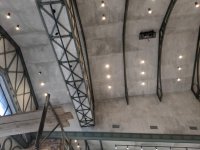 PXL_20211126_093510889.jpg136.9 KB · Views: 216
PXL_20211126_093510889.jpg136.9 KB · Views: 216 -
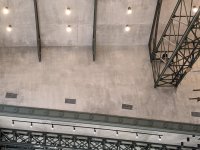 PXL_20211126_093831182.jpg223.9 KB · Views: 95
PXL_20211126_093831182.jpg223.9 KB · Views: 95 -
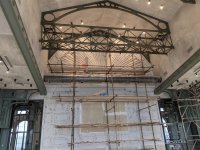 PXL_20211126_093622976.jpg259.7 KB · Views: 97
PXL_20211126_093622976.jpg259.7 KB · Views: 97 -
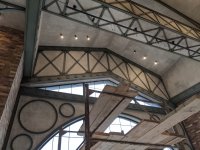 PXL_20211126_093606586.jpg228.7 KB · Views: 225
PXL_20211126_093606586.jpg228.7 KB · Views: 225 -
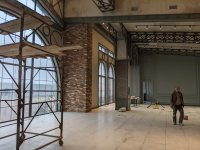 PXL_20211126_093559328.MP.jpg246.3 KB · Views: 206
PXL_20211126_093559328.MP.jpg246.3 KB · Views: 206 -
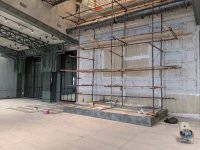 PXL_20211126_093518185.jpg258.5 KB · Views: 205
PXL_20211126_093518185.jpg258.5 KB · Views: 205 -
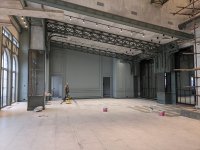 PXL_20211126_093515220.jpg227.2 KB · Views: 252
PXL_20211126_093515220.jpg227.2 KB · Views: 252
Last edited:
You can start from D.B.Keele constant-beamwidth transducer theory:
Don Keele's CBT (Constant Beamwidth Transducer) Page
Thanks, I will look into it.
Don't these types of acts usually bring thier own PA equipment? Weddings are social events so while there is usually music people want to be able to interact, so covering the whole space with the same SPL is usually not desirable. My experience doing wedding over the past 40yrs is that you only need speech coverage for the whole room and the higher SPL capability should be directed at the dance floor as much as possible.The room is... intended for live music as well as DJ, it a wedding hall.
Speakers should always be aimed at the listeners and not the surfaces as much as possible, ideally that would mean flying them near the ceiling and angling them down.I am considering toeing in the speakers to criss cross the room, to get later reflections from the opposite side walls which might or might not have diffusion on the wall.
There is no getting rid of all reflections indoors especially at low frequencies. The ideal speaker system for your venue may have a much narrower coverage.My understanding is a 80 to 90 degreee horizontal coverage will aim the speaker to the opposite side covering the dance floor and reducing or essentially getting rid of the closest side wall reflection.
No that is a gross over generalization, to achieve that response the array would have to be floor to ceiling in your venue. The array (aka column speaker) you are more likely to chose would only perform that way at mid and high frequencies.A line array has 100 degree horizontal pattern plus from what i understand it throws the music as far as it can,
Line arrays are often not the best solution inside buildings but that doesn't stop people from using them. You are doing the right thing here education yourself before equipment is purchased, as you can see there is more involved in selecting the right equipment and then getting them correctly installed than you may have realized.
And most of all what else do I need to take in consideration that the fundamental articles do not cover?
This will be a difficult room, and suggest you PM our simon7000 here for suggestions.
Ive attached pictures perhaps seeing them would make it more cut and dry.
Oh, what an apartment!
Also you must try some FIR filtering for room compensation. See OpenDRC from MiniDSP or something similar.
Don't these types of acts usually bring thier own PA equipment? Weddings are social events so while there is usually music people want to be able to interact, so covering the whole space with the same SPL is usually not desirable.
Yeh, they do but like I mentioned, I am purely doing the acoustics and warned the owner that choosing loudspeakers is up to the audio engineer and you will need a good one, not one that just sells you the stuff but as the "expert" in town I am just doing my homework to be able to consult a little more than just the acoustics.
My experience doing wedding over the past 40yrs is that you only need speech coverage for the whole room and the higher SPL capability should be directed at the dance floor as much as possible.
Can you please confirm what you mean here? You mean two seperate speakers for speech and music? I get the part having music directed at the dance floor. But how do i cover the whole room while having the dance floor covered...?
Speakers should always be aimed at the listeners and not the surfaces as much as possible, ideally that would mean flying them near the ceiling and angling them down.
Yes, your correct I was thinking having them toed in with the main coverage aimed at the dance floor but the end of the 90 degrees away from the closest wall. I get your point, probably best to aim them directly to dance floor though a little toe in shouldn't hurt. So even a point source could be hanged from the ceiling?
There is no getting rid of all reflections indoors especially at low frequencies. The ideal speaker system for your venue may have a much narrower coverage.
Well, Im going to work hard to tame the low frequencies. When you say much narrower coverage are you saying more narrower than 90 by 60 aimed at the dance floor? Overall it seems your recommending a point source over line array?
No that is a gross over generalization, to achieve that response the array would have to be floor to ceiling in your venue. The array (aka column speaker) you are more likely to chose would only perform that way at mid and high frequencies.
Interesting. I get the basics of line array but need to read up a little more.
Line arrays are often not the best solution inside buildings but that doesn't stop people from using them. You are doing the right thing here education yourself before equipment is purchased, as you can see there is more involved in selecting the right equipment and then getting them correctly installed than you may have realized.
Yes, and certainly more than the basics on the net. The audio engineer recommende JBL VRX series which is line array but I thought that point source would be better.
Ive been around a while but I am into small room acoustics, home 2 channel with DSP or digital filters and just making sure that the right speakers are bought for the hall to complement the acoustics that the owner will fork out on.
Oh, what an apartment!
Also you must try some FIR filtering for room compensation. See OpenDRC from MiniDSP or something similar.
Yeh definintely a speaker management system that has enough taps for DSP and to control low frequencies.
This will be a difficult room, and suggest you PM our simon7000 here for suggestions.
Thanks so much, I will PM him see if he can chime in.
This is a common tactic among the hifi crowd. It keeps things in the clear for the longest time, it improves imaging and helps with the back wall.I am considering toeing in the speakers to criss cross the room,
One way to do this would be with a distributed speaker system in the ceiling, this could be a 70/100 volt system or just some small speakers.. it doesn't take much to deliver speech and background diner music. The dance floor is covered with a dedicated live sound PA system.Can you please confirm what you mean here? You mean two seperate speakers for speech and music? I get the part having music directed at the dance floor. But how do i cover the whole room while having the dance floor covered...?
Yes all better quality cabs have fly points built in.So even a point source could be hanged from the ceiling?
Yes... 60x40 may be sufficient and yes point source will do a better job of not spraying sound everywhere.Well, Im going to work hard to tame the low frequencies. When you say much narrower coverage are you saying more narrower than 90 by 60 aimed at the dance floor? Overall it seems your recommending a point source over line array?
Actually they are not.. it's a constant curvature array, they cannot be arranged as a line and therefore don't behave like a line. These things are a bit of an oddity, you will read more bad reviews about how harsh they are than good ones, they can cover a fairly large space but have to be flown to do so and really don't do any better a job than the same number of point source boxes. The only thing they have going for them is they look the part.The audio engineer recommende JBL VRX series which is line array
"it's a constant curvature array, they cannot be arranged as a line and therefore don't behave like a line." i think Conanski needs to explain this statement a little further...or get out more...
Trdat the pictures don't show the stage location clearly is it under the vaulted portion of the ceiling ?
Trdat the pictures don't show the stage location clearly is it under the vaulted portion of the ceiling ?
Last edited:
This is a common tactic among the hifi crowd. It keeps things in the clear for the longest time, it improves imaging and helps with the back wall.
That's the goal, Im trying to get the longest delay possible with the reflections. Also, the back wall is glass so its either going to reflect from the glass or a curtain over the glass so Id rather get it tilted so the reflections come from a opposite concrete wall, I am sure the spectral balance will be better.
From what I have understood for large venues early early reflections that detrimental are about within 30ms. Griesenger mentions 10-50 ms should be 2 times lower than the direct energy then he goes onto mentioning that 50ms to 150ms are maximmully distrubing and anything over 150ms adds to envelopement. But it will be to hard to rid of the reflections between 50ms to 150 as they will be most of the reflections.
I know Griesenger is an expert in opera and orchestra halls, and this is a weddig hall but helps with giving me an idea.
One way to do this would be with a distributed speaker system in the ceiling, this could be a 70/100 volt system or just some small speakers.. it doesn't take much to deliver speech and background diner music. The dance floor is covered with a dedicated live sound PA system.
Yes all better quality cabs have fly points built in.
Yes... 60x40 may be sufficient and yes point source will do a better job of not spraying sound everywhere.
Actually they are not.. it's a constant curvature array, they cannot be arranged as a line and therefore don't behave like a line. These things are a bit of an oddity, you will read more bad reviews about how harsh they are than good ones, they can cover a fairly large space but have to be flown to do so and really don't do any better a job than the same number of point source boxes. The only thing they have going for them is they look the part.
Great idea, Ill take that in consideration. Might not be feasable though, but I am presuming having a wider dispersion speaker for speech with more speakers might improve the speech inteligibility.
I like the idea of 60 by 40, I think it will complement the acoustics and reduce reflections and still have decent coverage across the dance floor and even the whole hall.
Okay, so a typical point source seems to be a better fit. Would a stereo pair be enough for a room like that?
The vaulted ceiling starts from the stage and tappers up to the back wall. It is a 3m portion in the middle between two lower sides. The front part that is on top of the stage about 5 or so meters high and it tappers up to about 9m at the back."it's a constant curvature array, they cannot be arranged as a line and therefore don't behave like a line." i think Conanski needs to explain this statement a little further...or get out more...
Trdat the pictures don't show the stage location clearly is it under the vaulted portion of the ceiling ?
The first photo attached gives you an idea of how the high ceiling is above the stage in the middle. The second is the middle part of the vaulted ceiling from front to back the third photo is the back(higher) part. While the last photo is a wider picture of the front part.
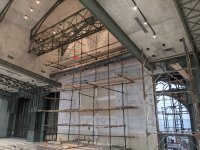
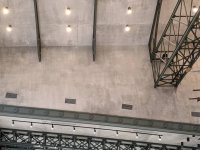
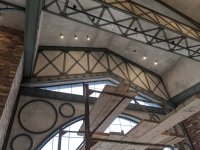
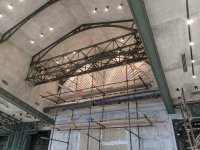
"it's a constant curvature array, they cannot be arranged as a line and therefore don't behave like a line." i think Conanski needs to explain this statement a little further...or get out more...
I was just out picking up a sound system... does that count?
As mentioned the VRX can only be arranged in an arc it can't be arrayed in a line and this arc can only get so big before it isn't useful anymore. This "feature" cuts both way in that it allows the system to cover a larger vertical area(perfect for a theater with a balcony) but at the same time it limits how much constructive interference can be generated as the system is practically limited to 3-4 boxes per hang. Now the length of an array determines how low it operates in line source mode, the stack-o-speakers has to be at least as tall as the wavelength of the lowest frequency it will reproduce, so 2 or 3 VRX(or any other LA module) a fullrange line array does not make.
Consider what your needs will be because narrow requires a larger device, which means they tend to give up at a higher frequency. When going for an asymmetrical H&V on a flat front device, the small one sets this limit.I like the idea of 60 by 40,
- Home
- Live Sound
- PA Systems
- Understanding Basics of LIne Array vs Point source